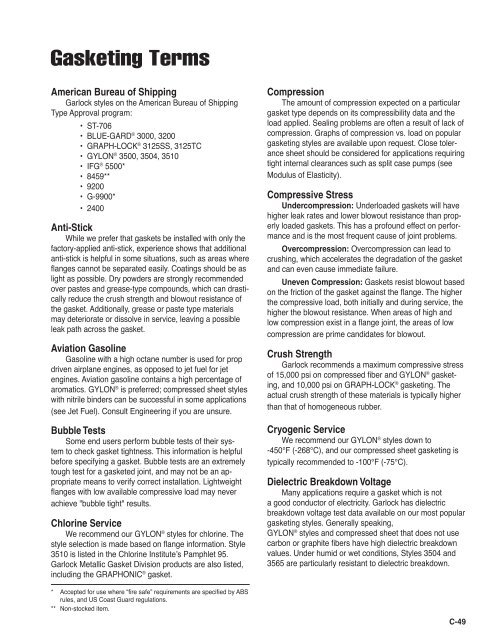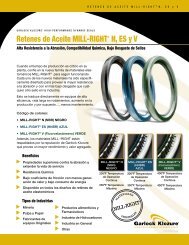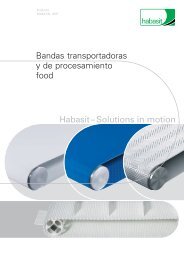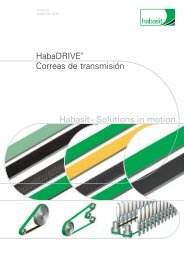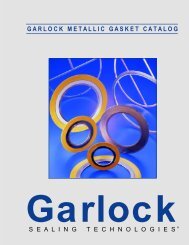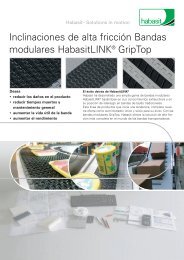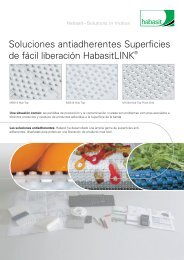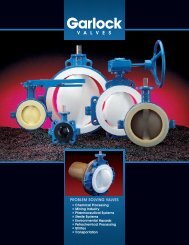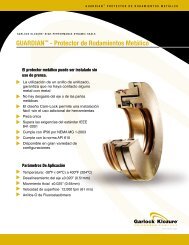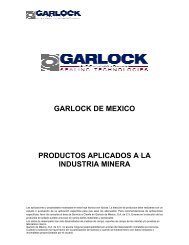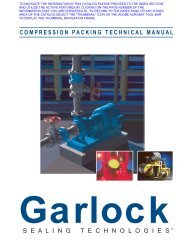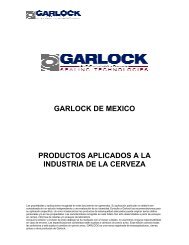<strong>Gasketing</strong> TermsAmerican Bureau of ShippingGarlock styles on the American Bureau of ShippingType Approval program:• ST-706• BLUE-GARD ® 3000, 3200• GRAPH-LOCK ® 3125SS, 3125TC• GYLON ® 3500, 3504, 3510• IFG ® 5500*• 8459**• 9200• G-9900*• 2400Anti-StickWhile we prefer that gaskets be installed with only thefactory-applied anti-stick, experience shows that additionalanti-stick is helpful in some situations, such as areas whereflanges cannot be separated easily. Coatings should be aslight as possible. Dry powders are strongly recommendedover pastes and grease-type compounds, which can drasticallyreduce the crush strength and blowout resistance ofthe gasket. Additionally, grease or paste type materialsmay deteriorate or dissolve in service, leaving a possibleleak path across the gasket.Aviation GasolineGasoline with a high octane number is used for propdriven airplane engines, as opposed to jet fuel for jetengines. Aviation gasoline contains a high percentage ofaromatics. GYLON ® is preferred; compressed sheet styleswith nitrile binders can be successful in some applications(see Jet Fuel). Consult Engineering if you are unsure.Bubble TestsSome end users perform bubble tests of their systemto check gasket tightness. This information is helpfulbefore specifying a gasket. Bubble tests are an extremelytough test for a gasketed joint, and may not be an appropriatemeans to verify correct installation. Lightweightflanges with low available compressive load may neverachieve "bubble tight" results.Chlorine ServiceWe recommend our GYLON ® styles for chlorine. Thestyle selection is made based on flange information. Style3510 is listed in the Chlorine Instituteʼs Pamphlet 95.Garlock Metallic Gasket Division products are also listed,including the GRAPHONIC ® gasket.* Accepted for use where “fire safe” requirements are specified by ABSrules, and US Coast Guard regulations.** Non-stocked item.CompressionThe amount of compression expected on a particulargasket type depends on its compressibility data and theload applied. Sealing problems are often a result of lack ofcompression. Graphs of compression vs. Ioad on populargasketing styles are available upon request. Close tolerancesheet should be considered for applications requiringtight internal clearances such as split case pumps (seeModulus of Elasticity).Compressive StressUndercompression: Underloaded gaskets will havehigher leak rates and lower blowout resistance than properlyloaded gaskets. This has a profound effect on performanceand is the most frequent cause of joint problems.Overcompression: Overcompression can lead tocrushing, which accelerates the degradation of the gasketand can even cause immediate failure.Uneven Compression: Gaskets resist blowout basedon the friction of the gasket against the flange. The higherthe compressive load, both initially and during service, thehigher the blowout resistance. When areas of high andlow compression exist in a flange joint, the areas of lowcompression are prime candidates for blowout.Crush StrengthGarlock recommends a maximum compressive stressof 15,000 psi on compressed fiber and GYLON ® gasketing,and 10,000 psi on GRAPH-LOCK ® gasketing. Theactual crush strength of these materials is typically higherthan that of homogeneous rubber.Cryogenic ServiceWe recommend our GYLON ® styles down to-450°F (-268°C), and our compressed sheet gasketing istypically recommended to -100°F (-75°C).Dielectric Breakdown VoltageMany applications require a gasket which is nota good conductor of electricity. Garlock has dielectricbreakdown voltage test data available on our most populargasketing styles. Generally speaking,GYLON ® styles and compressed sheet that does not usecarbon or graphite fibers have high dielectric breakdownvalues. Under humid or wet conditions, Styles 3504 and3565 are particularly resistant to dielectric breakdown.C-49
EmissionsThere is certainly a great deal of interest in limitingemissions of the numerous chemicals and other substancesregulated under the Clean Air Act. Garlock hasperformed testing in this area and our report, available onrequest, covers the effects of gasket type, compressiveload, internal pressure and flange finish on relative emissionslevels. The use of heavier flanges where possibleand the selection of premium gasket materials with goodsealability numbers are the easiest ways to reduce emissions.FDAStyle 3500 (Fawn) and Style 3510 (Off-White) complywith FDA regulation 21CFR177.1550. They meet ingredientand extract requirements. The fillers are also acceptableunder 21CFR177.2600 and coloring agents (whereused) under 21CFR178.3297. The branding ink complieswith 21CFR175.300. Style 3500 (Fawn) has USDA approvalfor direct contact in meat and poultry applications.Style 3504 (Blue), Style 3565 (ENVELON ® ), Style3591 (Gold), and Style 3594 (Green) comply with FDAregulation 21CFR177.1550. They meet the ingredientand extract requirements. The filler is listed in the FoodChemicals Codex (FCC 3rd Edition) and is consideredGRAS (generally recognized as safe – 21CFR170.30).The branding ink complies with 21CFR175.300.Style 3522 (Clear) complies with FDA regulation21CFR177.1550.The ingredients for Style 3540 (Microcellular)and Style 3545 (Microcellular with Rigid Core) complywith FDA regulations 21CFR177.1550, 21CFR182.1,21CFR182.1217, and 21CFR175.300. The branding inkcomplies with 21CFR175.300.The PTFE resins used in Style 3535 PTFE jointsealant comply with FDA regulation 21CFR177.1550. ThePSA tape used to hold the joint sealant material in placemeets 21CFR175.105.Fire TestsGarlock has developed a Fire Test Standard modeledafter industry fire tests API 589 and 607. Styles G-9900,9800, 9850, ST-706, IFG ® 5500 and GRAPH-LOCK ®styles have all passed this fire test. Test procedures andresults are available upon request.FlangesFlanges come in all shapes and sizes, and the type offlange used in a service has a large impact on the type ofgasketing material recommended. Standard ANSI raisedface flanges are best suited for use with compressed fiberand GYLON ® gaskets. Elastomer (rubber) gaskets may becrushed in these flanges.Flat faced non-metallic flanges seal best with elastomeric(rubber) gaskets, such as the various STRESSSAVER ® gasket styles. GYLON ® Style 3545 may alsobe suitable for some applications. Compressed fiber andstandard GYLON ® are frequently used in flat-faced carbonsteel flanges, but the compressive stress available inthese flanges is well below our minimums. The result isthat the gaskets are compressed very little; if there is asignificant flange irregularity present, the gasket may notseal. Since leakage rates of gaskets depend on the availablecompressive stress, the joint may not be as tight asthe customer would like.Glass-lined flanges are found in many chemicalapplications. Due to the inherent "waviness" createdwhen these flanges are fired to apply the glass, the softerGYLON ® styles such as Styles 3545, 3565, and 3504 arepreferred. The gap between the flanges, when placedtogether empty, must be measured before the gasket isordered. Gasket thickness should be four to five times themaximum gap observed.Stainless steel (SS) flanges are common in manyplants for chemical service, and often utilize low strengthSS bolts. Due to the chemicals present and the low compressivestress generated by the bolts, Styles 3545, 3565,and 3504 are often recommended. We do prefer, however,the use of high strength, strain-hardened stainless steelbolts.Flange FinishWe recommend the flange finish conform, wheneverpossible, to 30-55 serrations per inch, in a concentric orspiral pattern, cut with a 1/16" radius, round-nosed tool.This finish is usually difficult or impossible to create innon-circular flanges. We recommend that machined surfaceswhich can not be serrated have a surface finish witha multi-directional lay and roughness of 125-250 microinchRMS.Fuel AdditivesThe chemical MTBE (methyl t-butyl ether) has becomea very common fuel additive and gasketing compatibilityinquiries on this material are frequent. Garlockin-house testing has shown GYLON ® gasketing to beunaffected by MTBE. We have also found compressedsheet Styles 9850 and 3000 to be suitable for MTBE service.These materials are recommended for MTBE aloneor mixed with gasoline.C-50


